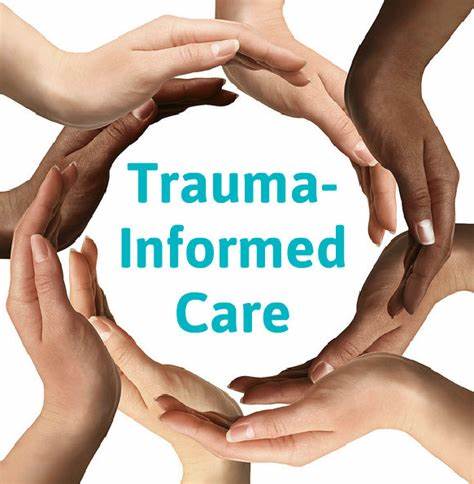Five strategies will transform your organization into a trauma-informed organization. Trauma informed organizations are better equipped to provide resources to clients, survivors, and staff. The following stories illustrate the need for trauma-informed care.

Preschool Children and Challenging Behaviors
Jamal was big for his age, had a quick smile, and an even quicker temper. He is African American with a diagnosed speech delay. Jamal received speech therapy, occupational therapy, and nurturing instruction in social skills. Jamal had never lived with his father, who was divorced from his mother. One day, a little girl broke away from her small group to grab a block from Jamal’s tower. It crashed and Jamal began kicking the blocks. When the teacher intervened, Jamal took a block and threw it at the teacher’s head. The incident lasted less than a minute.
Before the age of four, Jamal had experienced multiple Adverse Childhood Experiences (ACES), including the divorce of his parents, separation from his father, poverty, and racism, including implicit bias.
Immigrants and Trauma
In another organization, Miguel worked as an undocumented field worker, harvesting strawberries. Miguel was originally from Honduras where he described his father as a low-level criminal working in the drug cartels. His mother and sisters, listed on his application for legal assistance, were not discussed. Miguel worked long hours and was generous with follow co-workers and fellow co-workers and antagonistic towards his supervisor. His goal was to obtain a temporary residency status and learn to read and write. He was advised to apply for asylum as he had been personally threatened by members of the drug cartel, including his father. Miguel was fifteen. He was sullen with the lawyer and insisted that asylum “didn’t work”. He wanted a green card. After the second conversation with the lawyer and the social worker, Miguel returned to work, but never returned to the organization.
We can only guess Miguel’s trauma: familial violence, violence in the community, and unaccompanied immigration. Without trauma-informed care, he was unable to connect with the organization and receive temporary residence status.
Caring for Families
Ms. Amelia was an African American social worker, working with clients who had an incarcerated family member. She had access to Family Medical Leave to take care of her ill grandmother – the woman who had raised her. Ms. Amelia has worked for the organization for fifteen years. Two years ago, after completing her degree in social work through night school and tuition assistance, she was promoted to the position of social worker. Her salary was comparable with other social workers in the area – but not adequate for supporting two people. Ms. Amelia had compassion and empathy for her clientele. Her knowledge of the community helped her access resources for her clients. The agency offered trauma-informed care to clients though group support and mental health counseling.
Cause and Consequence of Trauma: Turnover in Nonprofit Organizations
A small non-profit in a poor area of town prided itself on its ability to provide comprehensive, holistic, and trauma-informed services to its clientele as it worked with high-unemployment rates in a violent and multi-racial community. The organization offered comparable salaries, but a better than average benefits package. Three managers in the program left within the space of year and line staff were promoted into their position. Two of the replacements left within the six months of their promotion. A cumulative amount of 77 years of institutional knowledge was lost and the ability to provide comprehensive and holistic services was hampered by the high turnover rate.
One returned to school full-time; one was hired for a promotion; one left the industry – all had different and plausible explanations for leaving. Despite the different reasons, there was also a commonality, “the agency did not seem to care.” Caring relationships are a key aspect of a trauma-informed organization, and this was lacking in the agency for its staff, despite its holistic approach to clients.
The people in each of the stories above: Jamal, Miguel, Ms. Amelia, and the employees in the organization with turnover, could all have experienced better outcomes in a trauma-informed organization.

5 Strategies to Establish Trauma – Informed Organizations
Establishing comprehensive trauma-Informed organization requires an organization-wide commitment, a lengthy planning process, training, time, and money.
More than 20 years of research has provided a wealth of information on what is broadly termed trauma-informed care. Alameda County described the six guiding principles of trauma-informed care: 1) an understanding of trauma; 2) safety and stability; 3) cultural humility and responsiveness; 4) compassion and dependability; 5) collaboration and empowerment; 5) resilience and recovery. Implementing trauma-informed care as separate initiatives (parenting curricula, domestic violence survivor groups, teaching practices in classrooms) are helpful and powerful. But a more powerful impact occurs when the agency transforms into a trauma-informed agency.
An agency should first and foremost conduct a trauma-informed self-assessment; it is a critical tool for examining existing practices and planning initiatives to transform the agency culture. The trauma-informed self-assessment enables an agency to construct strategies and techniques to become a trauma-informed agency. Trauma-informed agencies are far better equipped to provide resources to clients, survivors, and even to staff.
An innovative way to conceptualize the transformation of a program into a trauma-informed organization is to reflect on the Pyramid model. The Pyramid model is essentially a model for enhancing the social and emotional development of children in a classroom. The model rests on a base of an effective workforce with universal concepts of nurturing relationships and safe environments. Explicit training is required for a smaller portion of the population. The apex of the pyramid is intensive care for the most challenging behaviors. This model provides a framework for the strategies needed to implement a transformation in the organization.
- Begin by enhancing our workforce.
- Develop nurturing relationships at all levels of the organizations.
- Provide safe (physically and emotionally) environments.
- Participate in extensive and explicit training.
- Design intensive intervention protocols.

Resources:
Essentials of a Trauma Informed Agency
Alameda County: Developing a Trauma Informed Agency
SAMHSA: Trauma Informed Care
Thrive Initiative: Trauma Informed Webinar Trainings
